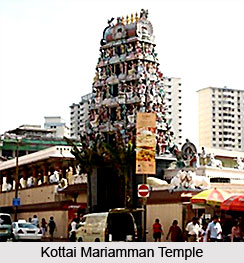 Salem district is regarded as a Geologist`s paradise, surrounded by hills and the landscape dotted with hillocks. The district of Salem possesses a vibrant culture dating back to the ancient Kongu Nadu. As a district, Salem has its significance in a number of aspects. There are several things in this district that are noteworthy by virtue of its location and social set-up. The date of human civilization in this district reaches far back to the stone ages. The existence of prehistoric culture in the Salem district is evident from the discovery of Paleolithic and Neolithic stone implements and dung ash heaps in and around this district of the Tamil Nadu state. The district of Salem comprises of eight taluks which are; Yercaud, Salem, Attur, Sankari, Omalur, Gangavalli, Idappadi and Mettur. In the year 1998, Attur division was newly formed and a new taluk called Valappadi was formed and the district of Salem attained its present administrative set-up.
Salem district is regarded as a Geologist`s paradise, surrounded by hills and the landscape dotted with hillocks. The district of Salem possesses a vibrant culture dating back to the ancient Kongu Nadu. As a district, Salem has its significance in a number of aspects. There are several things in this district that are noteworthy by virtue of its location and social set-up. The date of human civilization in this district reaches far back to the stone ages. The existence of prehistoric culture in the Salem district is evident from the discovery of Paleolithic and Neolithic stone implements and dung ash heaps in and around this district of the Tamil Nadu state. The district of Salem comprises of eight taluks which are; Yercaud, Salem, Attur, Sankari, Omalur, Gangavalli, Idappadi and Mettur. In the year 1998, Attur division was newly formed and a new taluk called Valappadi was formed and the district of Salem attained its present administrative set-up.
History of Salem district
The third century BC marks the arrival of Jainism and Buddhism in the district of Salem. Around the beginning of the Christian era, the existence of an economically and culturally advanced society in the Salem district two thousand years ago is evident from the discovery of silver coins of the Roman Emperor Tiberices Claudices Nero in Koneripatti of Salem in the year 1987. The rule of the Pandiyan dynasty over Salem district starts in the second century A.D. The fourth century A.D. witnessed the rise of the Pallava dynasty in the district of Salem and in the sixth century the rise of the Saivite principle was witnessed. The tenth century marks the rise of the Chola dynasty in this district and in the twelfth century the Hoysala Empire ruled over Salem. In the fourteenth century the district of Salem went under the rule of the Vijayanagar Empire. The fifteenth and the sixteenth century saw the rule of the Chalukyas and the Madurai Nayaks over the district of Salem respectively. The eighteenth century saw the rue of Hyder Ali and then his son Tipu Sultan over Salem and in this century Salem slipped into the hands of the British East India Company until India became independent in the year 1947.
Geography of Salem District
The district of Salem is located between eleven degree and fourteen minutes and twelve degree and fifty three minutes to the North Latitude and between seventy seven degree and forty four minutes and seventy eight degree and fifty minutes to the East Longitude. The total area covered by this district of Tamil Nadu is five thousand two hundred and five square kilometres. The maximum temperature in this district rises up to 37.9 degree Celsius and the minimum temperature is 18.9 degree Celsius. The total area under cultivation in the Salem district is 250573 hectares and rice, millets, pulses, sugarcane, groundnuts, etc are some of the crops which are grown here.
Tourism in Salem district
 Yercaud is a well-known summer resort in the Salem district. There are several places to see in Yercaud. The mild and cool climate prevailing at this place makes it an ideal summer retreat. Another tourist attraction is the Shervarayan temple. It is deep inside a narrow cavern with a rivulet rippling behind the idols. The `Kurunji` flowers which blossom once in twelve years also attract tourists. Coffee, spices like pepper, cardomom, fruits like orange, butter fruit, jack fruit are grown in Yercaud. There are several colonial buildings and churches in Yercaud. There is a fort at Sankagiri on a hillock which is said to have been the holding of `Theeran Chinnamalai`; an indigenous warrior who fought against the oppression of the British.
Yercaud is a well-known summer resort in the Salem district. There are several places to see in Yercaud. The mild and cool climate prevailing at this place makes it an ideal summer retreat. Another tourist attraction is the Shervarayan temple. It is deep inside a narrow cavern with a rivulet rippling behind the idols. The `Kurunji` flowers which blossom once in twelve years also attract tourists. Coffee, spices like pepper, cardomom, fruits like orange, butter fruit, jack fruit are grown in Yercaud. There are several colonial buildings and churches in Yercaud. There is a fort at Sankagiri on a hillock which is said to have been the holding of `Theeran Chinnamalai`; an indigenous warrior who fought against the oppression of the British.
Temples of Salem District
Temples in the district of Salem in the state of Tamil Nadu in India are mainly known for their characteristic mariamman Goddesses and festivals. Several temples with imposing towers and intricate sculptures are found in the Salem district, constructed by indigenous rulers, centuries before the British era. Some of the well-known temples in this district are the Taramangalam Shivan temple, the Kottai Mariamman temple, the Sukavaneswarar temple, Parsanna Venkatesha Perumal, etc.
The production of un-bleached sugar-vellam is one of the major cottage industries in the district of Salem. Another prominent cottage industry of this district is rope making. Both cotton and silk fabrics woven in the district of Salem find popular market throughout the state of Tamil Nadu. The district also possesses a large number of cinema theatres which is perhaps the largest in any district.






